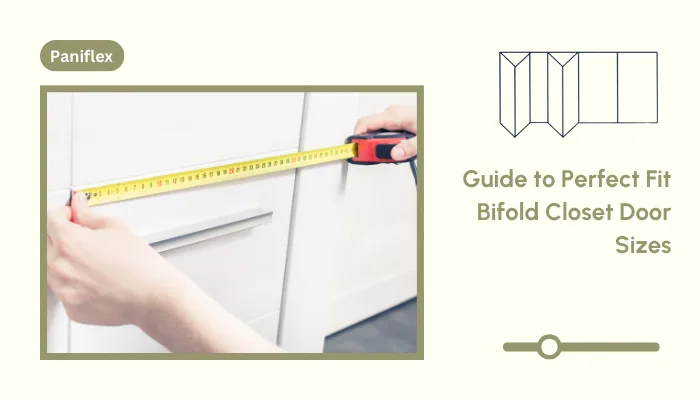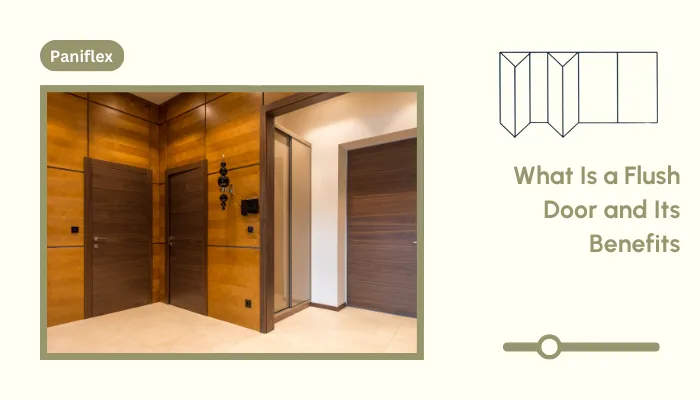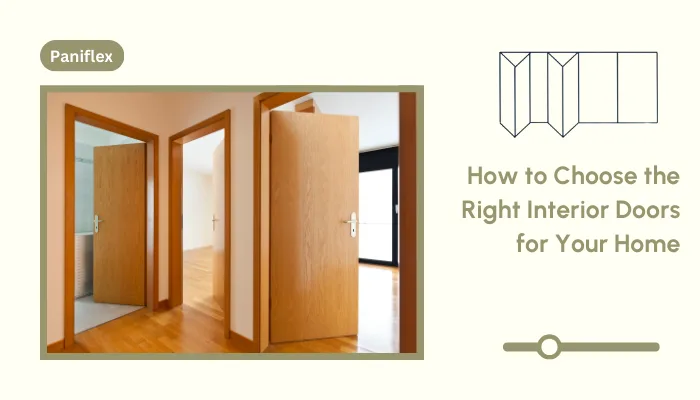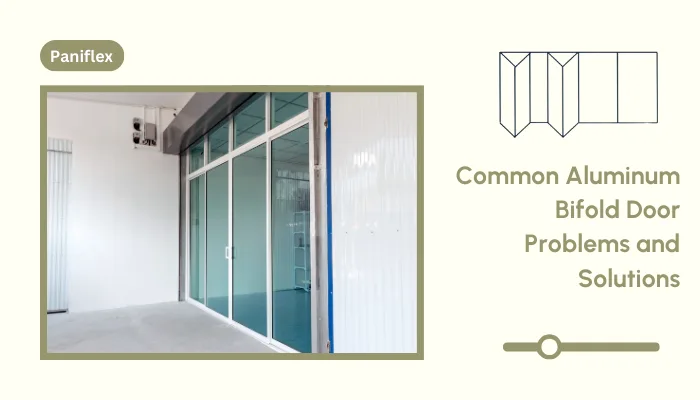Selecting the correct bifold closet door size is critical to achieving both functionality and visual consistency in a space. A poorly fitted door can lead to misalignment and operational issues and even detract from the overall appeal of a meticulously planned space. This is especially true for projects where precision and professional execution are paramount.
This guide provides a comprehensive overview of bifold closet door sizing, covering standard dimensions, custom solutions, and key factors to consider. With accurate measurements and the right approach, you can achieve a perfect fit that enhances both aesthetics and usability.
Ready to experience the benefits of custom closet doors? Explore our range of Paniflex products now.
Standard Bifold Closet Door Sizes
Choosing the correct bifold closet door size is essential for ensuring functionality, ease of installation, and aesthetic balance. Standard bifold doors are designed to fit most common closet openings, providing a practical solution that minimizes the need for extensive modifications. Understanding these standard dimensions helps streamline the selection process and ensures compatibility with existing architectural elements. Proper sizing enhances door operation, prevents alignment issues, and contributes to the overall design harmony of the space.
Bifold closet doors typically come in standard widths and heights, accommodating various closet openings. The most commonly available sizes include:
- Widths: 24″, 30″, 36″, 48″, 60″, and 72″
- Heights: 80″ and 96″
These standard dimensions are structured to fit typical rough openings, with allowances for framing and track installation. In most cases, bifold doors are designed with either two or four panels, depending on the width of the opening. For instance:
- A 24-inch or 30-inch door usually consists of two panels, each measuring half the total width.
- A 48-inch or 60-inch door includes four panels, providing a balanced appearance and smooth operation.
- Larger doors, such as 72-inch models, commonly use a four-panel configuration to maintain structural stability and ease of movement.
Standard bifold closet door sizes offer a practical and cost-effective option for many projects. By selecting the appropriate size and considering installation allowances, you can achieve a seamless and efficient result. However, for spaces with unique requirements, custom sizing may be necessary to ensure an optimal fit and aesthetic alignment.
Further Read: This informative guide explains standard screen door sizes and how to choose the right fit for your space. It covers essential measurements, installation tips, and factors to consider when selecting a screen door.
Suggested Watch: This video showcases 8 stylish and functional closet door options that can enhance your space while maximizing practicality. The designs complement different interiors, helping you choose the perfect fit for your needs.
In the next section, we will discuss how to measure bifold closet doors, ensuring precision and compatibility with standard or custom options.
Step-by-Step Guide to Measuring Bifold Closet Doors
Accurate measurements are essential for achieving a precise fit when installing bifold closet doors. Even minor miscalculations can lead to operational issues such as improper alignment, uneven gaps, or difficulty in opening and closing the doors. Whether you are working with standard sizes or custom solutions, following a structured measurement process ensures that the doors function correctly and complement the overall design of the space.
To obtain the correct measurements for bifold closet doors, follow these essential steps:
1. Measure the Width
- Use a reliable tape measure to determine the width of the closet opening at three points: top, middle, and bottom.
- Record the smallest measurement to account for any irregularities in the wall structure.
- Ensure that the width measurement allows for track installation and a slight clearance for smooth operation.
- For standard bifold doors, the rough opening should typically be ½ to 1 inch wider than the actual door size.
2. Measure the Height
- Measure the height of the opening at both the left and right sides to detect any variations in floor level.
- Use the shortest height measurement to ensure the door fits properly without binding at the top or dragging on the floor.
- Standard bifold doors typically require a rough opening height that is ½ to 1 inch taller than the door itself to accommodate the track and hardware.
Recommended Read: This Reddit thread offers valuable insights on bifold door sizing and installation. It features real-world tips and solutions from homeowners and professionals.
3. Check for Squareness
- Measure diagonally from one corner of the opening to the opposite corner to verify squareness.
- If the diagonal measurements differ significantly, the opening may require adjustments or custom doors to achieve a proper fit.
4. Consider Floor Clearance
- Account for the type of flooring in the closet area. Carpeting, tile, or hardwood flooring may affect the required clearance at the bottom.
- Leave sufficient space to prevent the door from dragging while maintaining a visually balanced installation.
5. Account for Track and Hardware Space
- When measuring, include additional allowances for the top track, bottom pivot brackets, and side clearance.
- Ensure that there is enough space for the door panels to fold without obstruction.
Pro Tip: Always measure twice before ordering bifold doors to account for any irregularities in wall and floor levels. Even minor discrepancies can impact door alignment and functionality.
Properly measuring bifold closet doors is crucial to achieving a seamless fit and ensuring long-term functionality. By carefully assessing width, height, squareness, and clearances, you can avoid costly installation issues and create a polished, professional result.
Recommended Watch: This video offers a complete step-by-step tutorial on adjusting bifold closet doors to ensure a precise fit within the closet door framing. Learn practical tips and techniques to achieve smooth operation and a flawless appearance.
In the next section, we will explore the sizing of custom bifold closet doors and discuss when and why custom solutions might be the best choice for your project.
Advantages of Custom Bifold Doors
Standard bifold closet doors may not always meet the unique requirements of a space. Variations in closet dimensions, design preferences, and functional needs often necessitate custom solutions. Custom bifold doors provide the flexibility to achieve a perfect fit, ensuring seamless integration with the architectural elements while enhancing both functionality and aesthetics. Whether dealing with non-standard openings or specific material and design choices, custom sizing offers precision that standard doors cannot accommodate.
Choosing the right custom bifold door size involves careful consideration of factors such as space constraints, material selection, and hardware compatibility. With customized solutions, professionals can ensure an exact match to project specifications, delivering a refined look and smooth operation.
Custom bifold doors offer several advantages, making them an ideal choice for projects with unique requirements:
Tailored Fit for Irregular Openings
Older buildings and custom-built spaces often have uneven or non-standard openings. Custom sizing ensures the door fits perfectly, avoiding gaps and misalignment issues. Precise measurements allow for adjustments to account for uneven floors, walls, and ceiling heights.
Enhanced Design Flexibility
Custom options allow for a wider range of materials, finishes, and panel configurations. Whether incorporating mirrored panels, decorative accents, or specific wood grains, custom doors can match the design vision. Professionals can choose unique folding mechanisms and panel arrangements to suit the space’s functional and aesthetic needs.
Maximized Space Utilization
Custom bifold doors can be designed to optimize available space, especially in areas with limited clearance or unique layouts. Slimmer panels or alternative folding patterns can improve accessibility and usability.
Recommended Read: Explore creative closet door alternatives with this insightful guide
Adaptability to Specialty Hardware
Standard doors may not accommodate specialty hardware, such as heavy-duty tracks or unique hinge systems. Custom doors can be designed to integrate seamlessly with specialized hardware for improved durability and performance.
Superior Material Selection
Customization allows for higher-quality materials that enhance durability and longevity. Options include solid wood, glass, composite, and eco-friendly materials tailored to specific project requirements.
Recommended Read: This insightful Reddit discussion offers expert advice and practical tips on the opening requirements for a 36×80 bifold door.
Custom bifold closet doors are ideal for spaces that demand precision, unique aesthetics, and optimal functionality. They provide a tailored fit that enhances the space’s visual appeal and usability while accommodating non-standard dimensions and specific design requirements.
In the next section, we will discuss material considerations and their impact on sizing. This will help you select the best materials for durability, aesthetics, and ease of maintenance.
Material Considerations and Their Impact on Sizing
Selecting the right material for bifold closet doors is crucial, as it directly affects not only the door’s appearance but also its durability, weight, and overall functionality. Different materials have unique characteristics that influence door sizing, installation requirements, and long-term performance. Understanding these factors helps in making informed decisions that ensure a precise fit and optimal operation.
Each material presents distinct advantages and challenges, influencing the sizing and performance of bifold doors. This table outlines the different materials and their impact on bifold closet door sizing:
| Material | Impact on Sizing | Advantages | Considerations |
| Wood | • Heavy material requiring strong tracks and additional support.• Prone to expansion and contraction due to humidity, requiring allowances for seasonal movement. | • Timeless, elegant appearance.• Excellent durability and sound insulation.• Wide variety of finishes available. | • Needs acclimatization before installation to prevent warping.• May require periodic maintenance.• Higher cost compared to other materials. |
| MDF (Medium-Density Fiberboard) | • Heavier than some alternatives, requiring sturdy track systems.• Needs precise cutting to prevent moisture absorption and swelling. | • Cost-effective and smooth surface for painting.• Resistant to warping and shrinking.• Uniform texture and finish. | • Prone to moisture damage if not properly sealed.• Not as strong as solid wood.• May require additional reinforcement for larger doors. |
| Plywood | • Lighter than solid wood, making installation easier.• Less prone to expansion and contraction. | • Strong and durable with layered construction.• Resistant to cracking and warping.• Available in various veneers. | • Edge finishing is necessary for a polished look.• Moderate resistance to moisture.• Quality varies depending on grade. |
| Glass | • Requires precise sizing to accommodate thickness and weight.• Heavier panels demand reinforced tracks and hinges. | • Provides a modern, sleek look.• Enhances natural light distribution.• Available in frosted, clear, or decorative options. | • Requires regular cleaning and maintenance.• Fragile compared to other materials.• Higher installation complexity. |
| Composite Materials | • Lightweight and versatile, easy to size and install.• Minimal expansion and contraction. | • Affordable and low maintenance.• Resistant to moisture and termites.• Variety of textures and finishes. | • May lack the authenticity of natural wood.• Durability varies depending on quality.• Limited refinishing options. |
| Metal | • Slim profiles with a high strength-to-weight ratio.• Precision sizing is required for proper fit due to minimal flexibility. | • Extremely durable and long-lasting.• Ideal for industrial and contemporary designs.• Resistant to moisture and pests. | • Can be prone to dents and scratches.• Limited style options compared to wood.• Higher cost for custom finishes. |
Pro Tip: When choosing materials for bifold doors, consider the room’s humidity levels. Wood expands and contracts with moisture, while composite and metal options offer better stability in high-humidity environments.
Choosing the right material for bifold closet doors is essential to balancing aesthetics, functionality, and durability. Understanding how different materials affect sizing, installation, and maintenance allows professionals to make informed decisions that align with project requirements.
In the next section, we will explore troubleshooting tips for sizing issues.
Troubleshooting Bifold Door Sizing Issues
Proper bifold door sizing is critical to achieving smooth functionality and a flawless appearance. However, common sizing mistakes can lead to misalignment, operational difficulties, and aesthetic inconsistencies. Addressing these challenges early ensures a professional finish without costly adjustments.
At Custom Door & Mirror, we specialize in providing precision-made bifold doors tailored to exact specifications. These doors help professionals avoid common pitfalls and achieve seamless installations.
Misaligned Panels
Misaligned panels often result from inaccurate width and height measurements or uneven floors and walls. Even slight deviations can cause operational issues and affect the overall aesthetic.
How Custom Door & Mirror Helps:
We manufacture doors based on precise measurements to ensure proper alignment and minimize the need for on-site adjustments. Our expert measurement guides assist in capturing accurate dimensions and prevent installation challenges.
Excessive Gaps Around the Door
Oversized bifold doors or miscalculated clearances can lead to noticeable gaps that compromise privacy and visual appeal. Incorrect track placement can also contribute to this issue.
How Custom Door & Mirror Helps:
Our custom-fit doors are designed to account for necessary clearances, ensuring a tight, seamless fit. We provide consultation on gap allowances, helping professionals achieve optimal results without compromising door movement.
Difficulty in Opening and Closing
Improper door sizing can result in tight-fitting panels that hinder smooth operation. Inadequate allowances for tracks and pivot systems can also contribute to resistance during opening and closing.
How Custom Door & Mirror Helps:
Our bifold doors are engineered with precise allowances to ensure effortless movement. We also supply high-quality hardware systems that are compatible with our doors, guaranteeing long-term performance and ease of use.
Uneven Panel Gaps
Irregularities in wall and floor surfaces or inconsistent panel sizing can create uneven gaps between panels, disrupting the door’s overall symmetry and functionality.
How Custom Door & Mirror Helps:
We craft our doors with careful attention to detail, compensating for minor irregularities to maintain uniform panel spacing. Our team offers expert advice on how to adjust for non-standard openings to achieve a polished finish.
Doors Rubbing Against Flooring
Incorrect height measurements or insufficient bottom clearance can cause bifold doors to scrape against flooring, leading to wear and operational issues.
How Custom Door & Mirror Helps:
We customize door heights to provide appropriate bottom clearance, ensuring compatibility with various flooring types, such as carpets, tiles, or hardwood. Our sizing recommendations take flooring thickness into account to prevent future problems.
Panels Bowing or Warping
Changes in humidity and temperature can cause door panels to expand, contract, or warp, particularly when low-quality materials are used.
How Custom Door & Mirror Helps:
We use high-quality, moisture-resistant materials that maintain their shape and integrity over time. Our experts help clients select the best material options for specific environmental conditions to prevent warping.
Incorrect Door Swing Direction
Poor planning during installation can result in doors swinging in the wrong direction, causing obstructions and limiting accessibility.
How Custom Door & Mirror Helps:
We provide installation-ready doors with pre-configured swing directions based on project specifications. Our customizable solutions allow professionals to specify the preferred door swing to fit the space efficiently.
Recommended Read: Looking for guidance on bifold door measurements? This Reddit thread offers useful tips and experiences shared by homeowners and professionals to help you measure accurately for a perfect fit.
Troubleshooting bifold door sizing issues requires a careful approach to measurements, material selection, and installation planning. At Custom Door & Mirror, our expertise and precision-engineered solutions eliminate common challenges, ensuring that your bifold doors fit and function flawlessly.
Suggested Read: Curious about the cost of custom closet doors? This guide from Paniflex provides a detailed breakdown of pricing factors, helping you understand what influences the cost and how to choose the best option for your budget.
Ready to experience the benefits of custom closet doors? Explore our range of Paniflex products now.
Summing Up: Achieving Optimal Bifold Door Sizing
Achieving the perfect fit for bifold closet doors requires a comprehensive understanding of standard dimensions, precise measurement techniques, and material considerations. Selecting the correct door size is essential to ensuring seamless functionality, visual consistency, and long-term durability. Whether working with standard options or custom solutions, every step—from measuring to installation—plays a critical role in preventing common issues such as misalignment, gaps, and operational difficulties.
Custom Door & Mirror provides tailored solutions designed to meet each project’s specific requirements. Our precision-crafted bifold doors, expert guidance, and high-quality materials ensure that every installation meets the highest standards of performance and aesthetics. Whether you have unique closet openings, specialized design needs, or challenging environmental conditions, our custom sizing options offer a seamless and reliable solution.
Ensure a perfect fit with our custom bifold doors. Request a consultation and get started with your order now.






